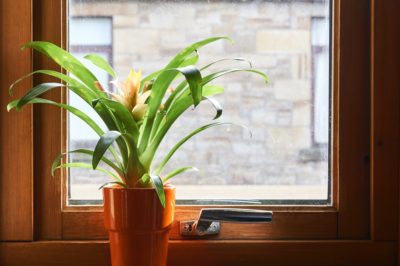Growth Habits
All indoor bromeliads need a temperature range between 70 to 90°F (21 to 32°C) during the day and 50 to 70 °F (10 to 21°C) at night. After that, however, growth habits determine care. Epiphytic bromeliads obtain food and water from the air through their leaves. Terrestrial bromeliads use their roots for the same purpose. Saxicolous bromeliads, which grow on rocks, aren’t usually used as houseplants.
Choosing Plants
There are many different species and varieties of bromeliads. These are popular:
- Flaming Sword Plant (Vriesea splendens) – leaves mottled with maroon and a bright red flower bract.
- Medusa’s Head (Tillandsia caput medusae) – thin, twisted spiky leaves like Medusa’s hair.
- Queens Tears (Billbergia nutans) – dangling flower bracts drip nectar.
- Blushing Bromeliad (Neoregelia carolinae) – showy striped leaves turn bright pink or red before the plant blooms.
Light Comes First
Adequate light is the most important factor in growing bromeliads indoors, especially if you want them to bloom. Light tolerance differs, but direct exposure to sunlight for extended periods can cause leaf damage. Areas with bright indirect light are ideal. In winter, a south-facing windowsill is a good choice. In summer, any bright window with a translucent shade to keep out direct sun will be fine for most bromeliads.
Soil – Yes or No?
Terrestrial bromeliads are usually grown in special soil like a cactus mix or orchid mix. These supply excellent drainage, which is important to prevent root rot. For those who prefer to mix their own, a mixture of equal parts sphagnum peat moss, medium grade perlite and fine fir bark will provide good drainage and high acidity. Coconut coir can be substituted for the fir bark.
Water Correctly
Bromeliads can handle a little drought but not over-watering; their roots will rot. Water thoroughly with a non-metal container until water runs out the drain holes. Don’t water again until the top two inches of soil is dry. Tank bromeliads collect water in central cups; drain them weekly to prevent stagnant water. Keep humidity high with twice daily misting. Rainwater or distilled water are the best choices.
How and When to Fertilize
Most bromeliads grow fairly slowly. Push them with too much fertilizer and their bright colors will become muddy. Always use water-soluble fertilizer for epiphytic plants. Dilute the fertilizer to one-half or one-quarter strength and spray the plants. Place slow-release pellets around the base of a terrestrial plant. Don’t put pellets or powdered fertilizer in the tank of a bromeliad.
